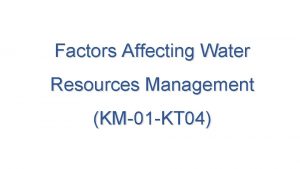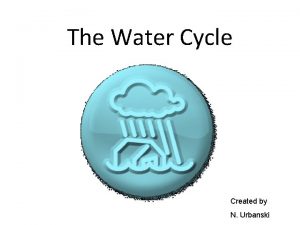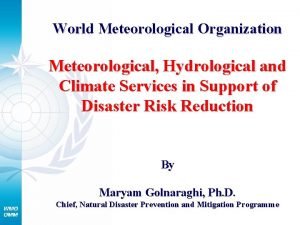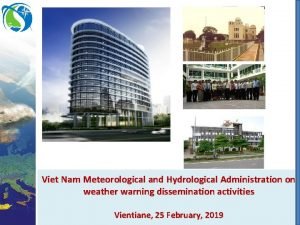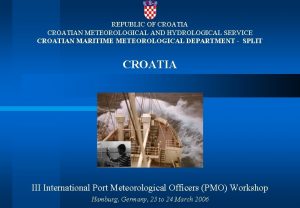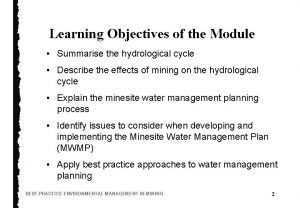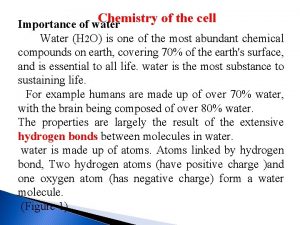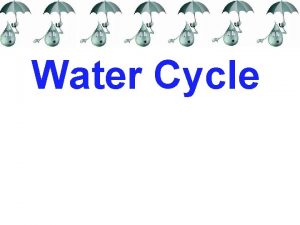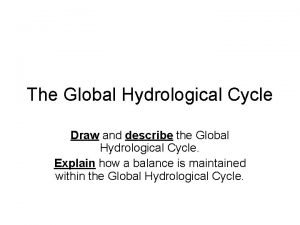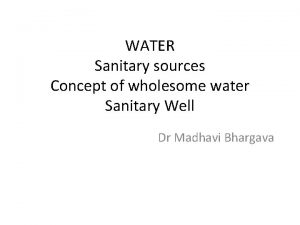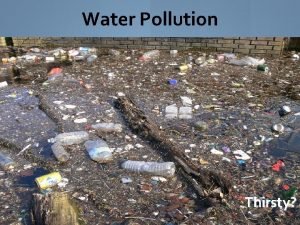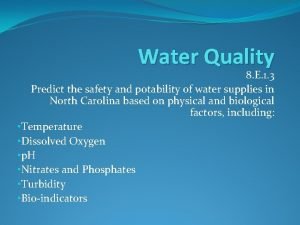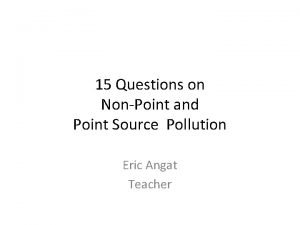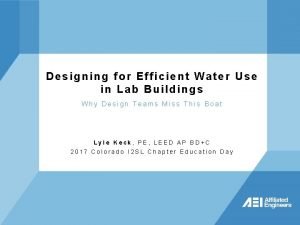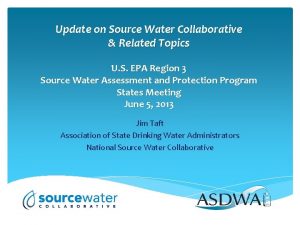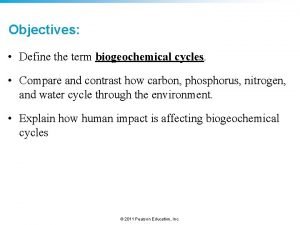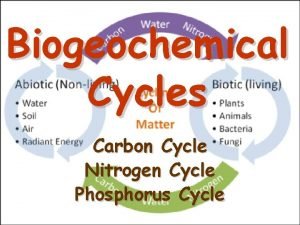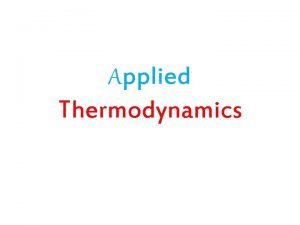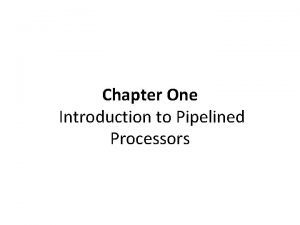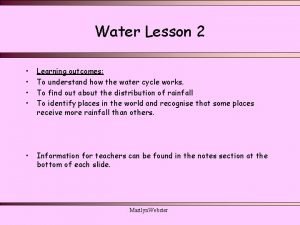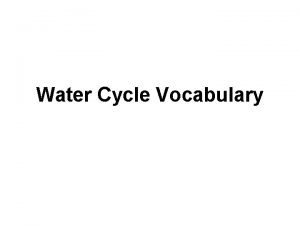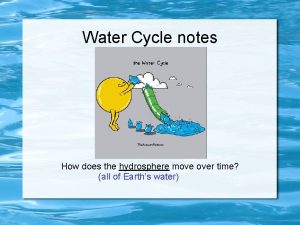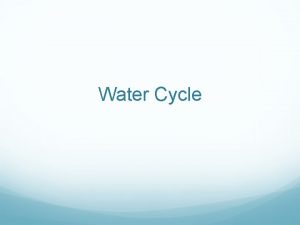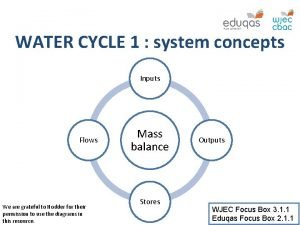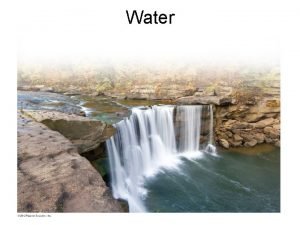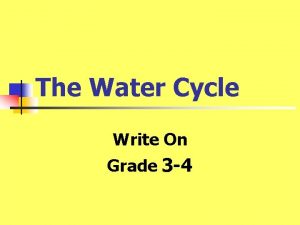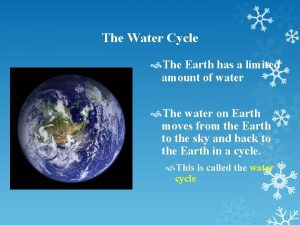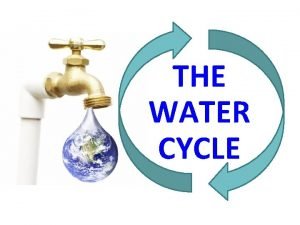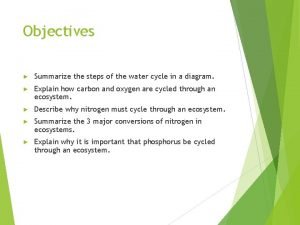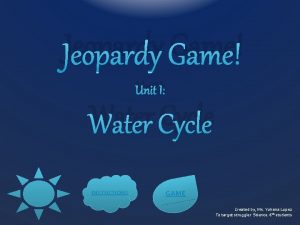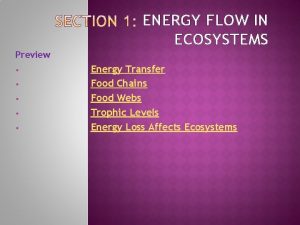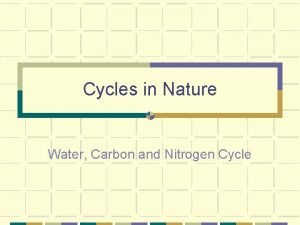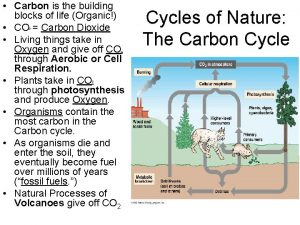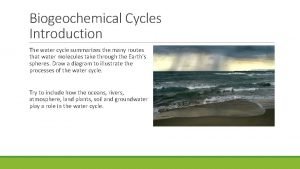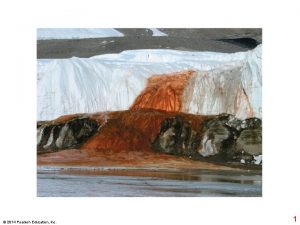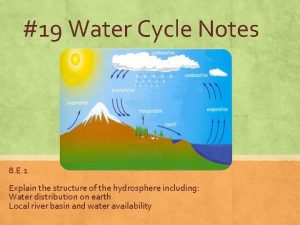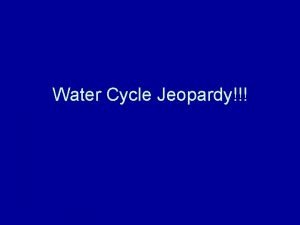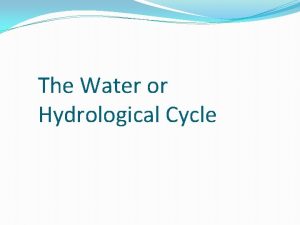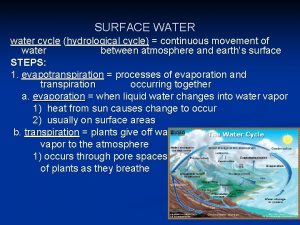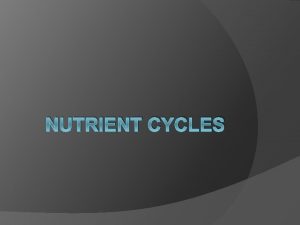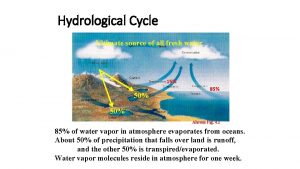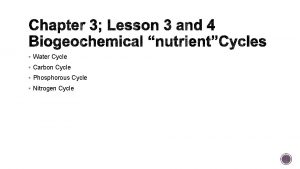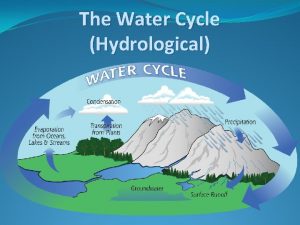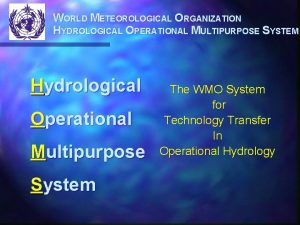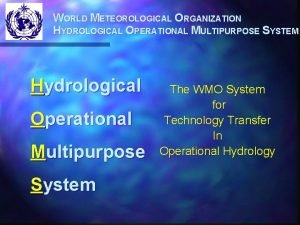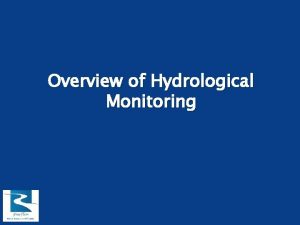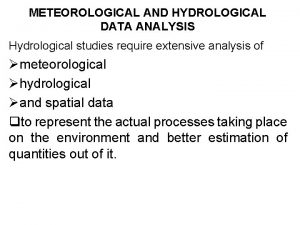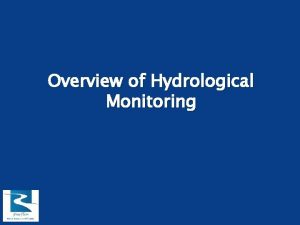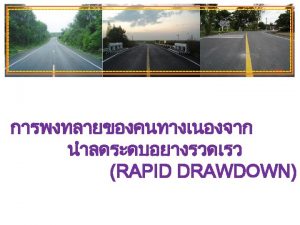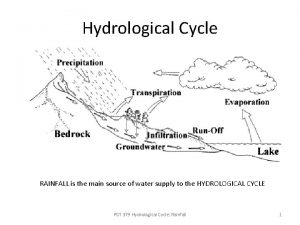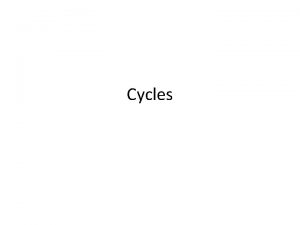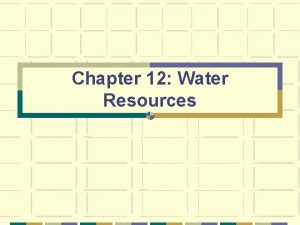Source of Water Sources of Water Hydrological Cycle


















































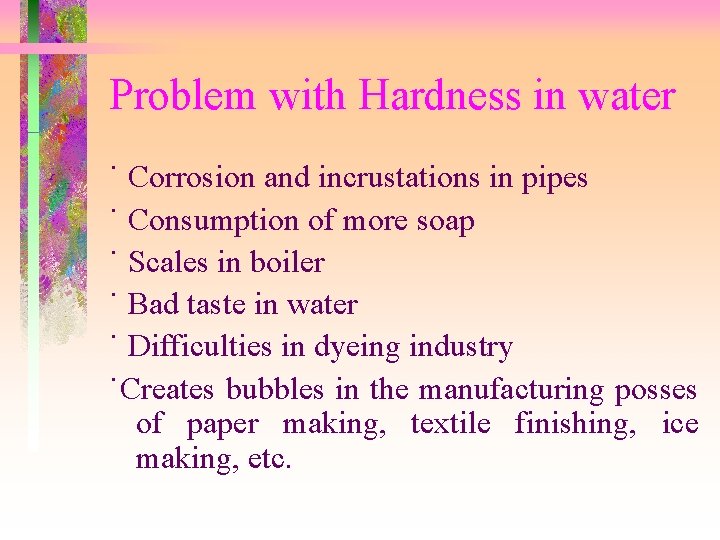

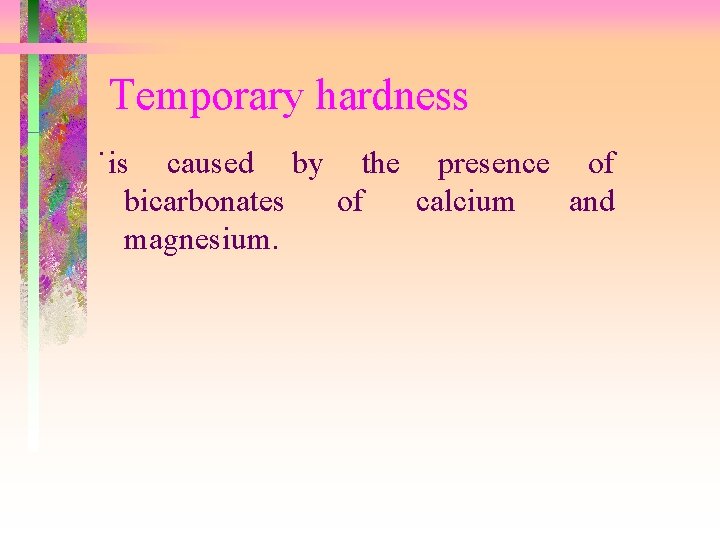
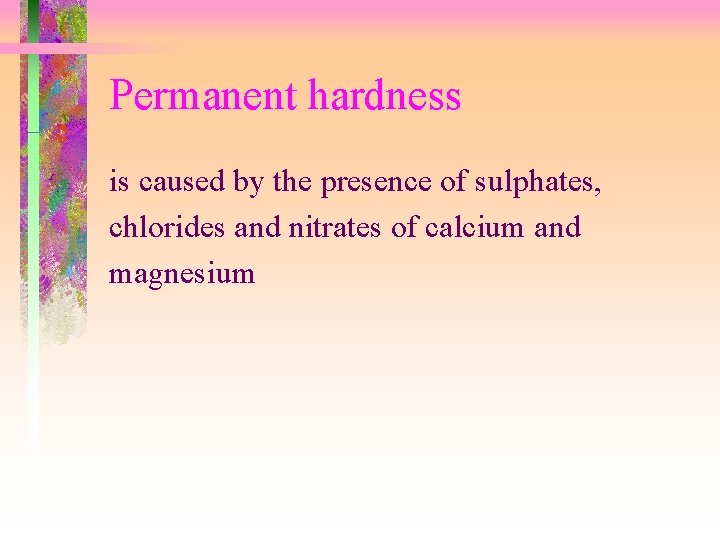
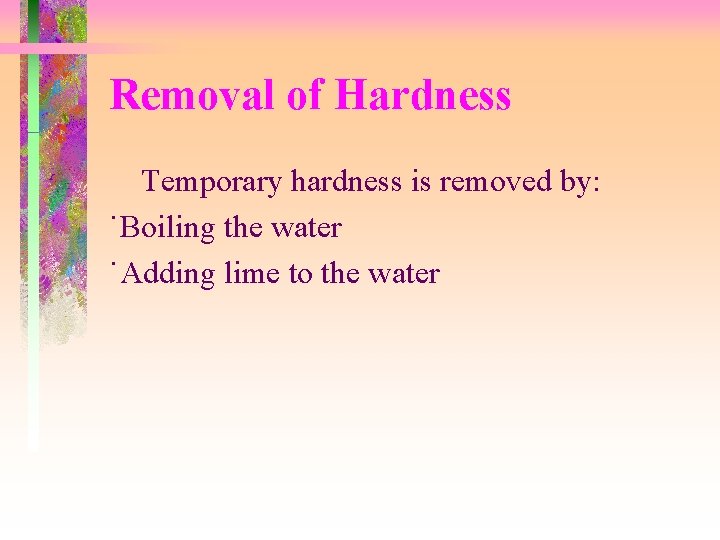
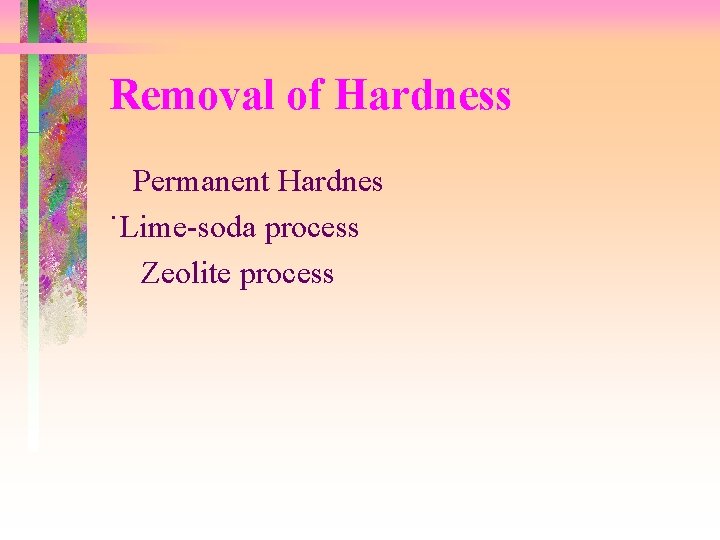
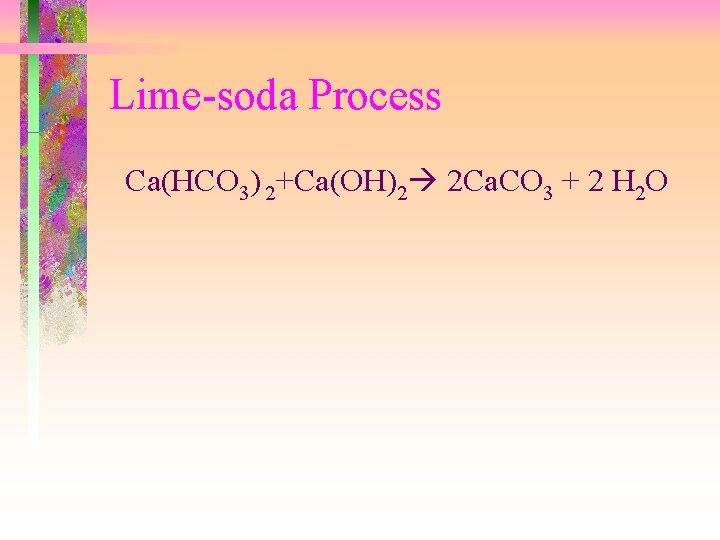
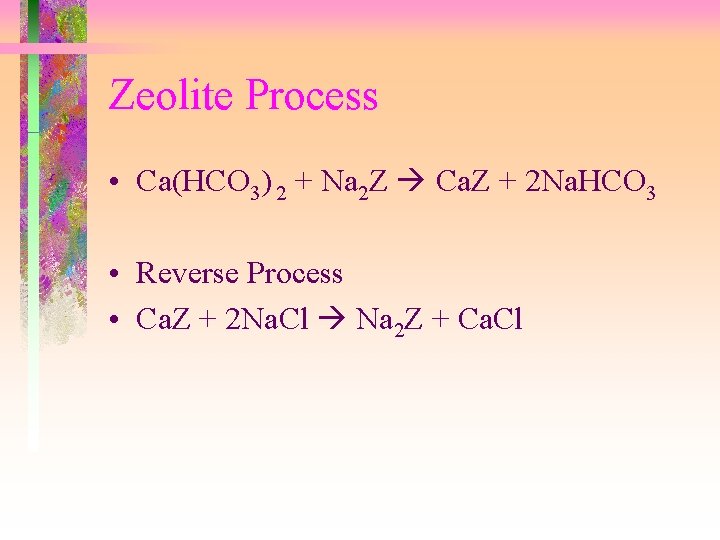
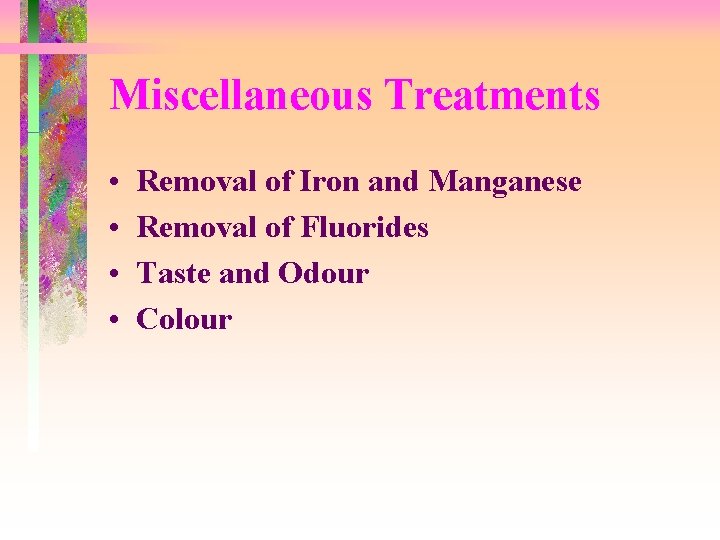

- Slides: 60

Source of Water

Sources of Water • Hydrological Cycle - Rain – Surface runoff – water storage - infiltration – ground water – evaporation – transpiration • Rain – Surface Water – Groundwater • Aquifer

Choice of Source • • Location of source Quantity of water available Quality of water Cost of the entire scheme

Surface water • Surface water source may be further classified as: • - lakes • - Impounding reservoirs • - River, streams, irrigation canals • The area where water is collected for water supply purpose is called catchment or watershed.

Ground Water • Aquifer • An aquifer is a layer of pervious material beneath the ground surface and underlied by impervious stratum. • Water table • The free surface of water in the aquifer is called water table • Sources - Spring - Wells

Characteristics of Ground Water • Generally ground water is clear and colorless. When water seeps down into ground, it dissolves inorganic salts. • Therefore, sometimes harmful

Sources of Water in Hong Kong • • natural catchment Guangdong Province of China. Administration by Water Authority Responsible for supply, treatment and distribution

Quality of Water

Quality Monitoring • conform both chemically and bacteriologically to the Guidelines for Drinking Water Quality (WHO, 1984). • Parameters: – Physical – Chemical : a) inorganics – b) organic – Biological – Bacterialogical – Radiological

• Physical : e. g. p. H, conductivity, turbidity, colour, etc. • Chemical : – a) inorganics e. g. nurients, ions, heavy metals etc. – b) organic e. g. trihalomethane, pesticides etc. • Biological : e. g. algae, zooplankton, macroinvertebrate, fish, • Bacterialogical : total coliform, E. Coliform, plate count • Radiological : e. g. gamma emitters.

Consumer Complaints • Consumers can file complaints regarding the quality of water. Typical complaints on the quality of water in Hong Kong are : – discoloured water – tastes and odours – cloudy, milky or chalky water

Introduction to Water Treatment

Why water need treatment • The water is polluted by the people inhabiting the catchment. • Water carries bacteria, some of which are pathogenic, and can cause water-borne diseases. • Factories let off water into rivers and pollute the water. • Surface run-off dissolve and minerals.

Impurities - Physical impurities - Chemical impurities - Bacteriological impurities

• Physical impurities can affect the color, taste, odour and turbidity to the water. • Chemical impurities cause hardness in water. Excess quantities of metals and dissolved gases cause corrosion to pipes and fittings. • Bacteriological impurities are due to pathogenic bacteria which spread diseases.

Objectives of Water Treatment · To remove colour, objectionable taste and odour · To remove dissolved gases, dissolved and suspended impurities and harmful minerals · To remove suspended and dissolves organic impurities · To remove harmful bacteria · To make the water safe and attractive for drinking and domestic purposes

Components of a Treatment Plant • Intake work including pumping plant · Plain sedimentation tank · Clairifier-flocculator: (coagulation & flocculation) · Filter · Disinfecting plant · Water storage reservoir. · Pumping plant · Distribution system · Other processes Hardness (Colour, Iron and manganese, Fluoride, )

Treatment processes • • Source Pre-chlorination Flocculation Sedimentation Filtration Post-chlorination Storage and pumping Distribution system

Plain Sedimentation • Suspended and colloidal impurities that are settleable are separated in the sedimentation tanks by gravitation.

Principle of Sedimentation • The main principle of sedimentation is to allow water to rest or flow at a very slow velocity so that the heavier particles settle down due to gravity.

Types of Sedimentation Tanks • Sedimentation tanks can be • Horizontal flow tanks ˙Vertical flow tanks

Horizontal Flow Tanks • The direction of flow in the tank is essentially horizontal. • (a) Rectangular tanks • (b) Circular tanks – Radial flow tanks – Circumferential flow tanks

Vertical Flow Tanks

Sedimentation with coagulation • Colloidal particles which are fine particles of size finer than 0. 0001 mm carry electrical charges on them. These are continuously in motion and will never settle down under gravity.

Coagulation • The process of adding certain chemicals to water in order to form an insoluble, gelatinous, flocculent precipitate for absorbing and entraining suspended and colloidal matter is called coagulation.

Purpose of Coagulation • The fine particles are removed rapidly and turbidity is reduced to about 20 ppm. The bacterial load also is reduced by 5%.

Principle of Coagulation · Floc Formation · Electric Charges · Floc Formation – forming of a thick gelatinous precipitate which is insoluble in water and settle. • Electric Charges – Colloidal particle possess negatively charged ions. The floc thus attracts the colloidal particles and makes settle down.

Coagulants • The common coagulants used are: • Salts of aluminium: - alum (明礬), filter alum, Sodium aluminate • Salts of iron: - Ferrous sulphate, Ferric chloride

Chemistry of Coagulation • When alum is added to water, Al 3+ ion will hydrolyze to different charged hydrolysis products depending on the p. H : • Al(H 2 O)6 3+ < == > [Al(H 2 O)5 OH] 2+ < == > [Al(H 2 O)3 (OH)3] (s) < ==> Al(H 2 O) (OH) ] 2 4

Polyelectrolytes · Polyelectrolytes are increasingly used in water treatment as primary coagulant, flocculant coagulant aid or filter aid. · They are synthetic long-chain organic compounds which contain different monomers. · They can exhibit either positive (cationic), negative (anionic) or nonionic charge.

Advantages of polyelectrolytes · increase process stability and efficiency · improve water quality · improve sludge quality and reduce sludge quantity

Limitations of polyelectrolytes · expensive products · require careful control · improper dosing can cause serious filter problems filter blockage · require efficient mixing

Process of Coagulation and Sedimentation • • Feeding Mixing Flocculation Clarification.

Flocculation • Agglomeration of particles involve 3 separate mechanisms : • 1. Brownian motion • 2. stirring/agitating • 3. Differential settling

Clarifying • After flocculation, the floc is allowed to settle down in basins called clarifiers. The clear water is drained out for further purification. The detention period is about 1*1/2 - 3 hours.

Filtration • The process of filtration involves allowing the water to pass through a layers of sand called media which acts as strainers. The water is then collected by means of drains placed under the sand bed.

Objectives of Filtration • Remove colloidal and suspended matter remaining after sedimentation • Remove bacterial load

Theory of Filtration • • Mechanical straining Sedimentation or adsorption Biological Metabolism Electrolytic changes

Filter Sand The characteristics of the sand • Effective size : The effective size of a sand is the size of sieve, in mm, through which 10% of the sand (by weight) passes. It is usually denoted by D 10. • Uniformity coefficient : This is the ratio of the size of sieve through which 60% of the sample of sand passes to the effective size of sand.

Classification of Filters • • Gravity filters Slow sand filters Rapid sand filters Pressure filters

Types of Filter Media configuration in Hong Kong In Hong Kong, only rapid sand filter is used. Filtering materials can be single media filter or dual media filter.

Disinfecting • The process by which harmful bacteria are destroyed to make it safe for drinking is called Disinfecting. • Chemicals used for this purpose are called disinfectants.

Criteria for a Good Disinfectant • Capable of destroying pathogenic organisms within the contact time available. · Should NOT change the physical and chemical characteristics • Should not be toxic • Available at reasonable cost · Should have residual concentration • Detectable in the water by simple tests • Easy in transportation and application

Methods of Disinfecting • • Boiling water Ozone gas treatment Excess lime treatment Iodine and bromine treatment Ultraviolet rays treatment Potassium permanganate treatment Chlorination

Chlorination • The process is economical and cheap • It is harmless to human beings • It is reliable and effective · Residual chlorine can be maintained in the water • Easy to apply and ease to measure Disadvantages of Chlorination • Formation of trihalomethanes (THMs) such as carcinogen chloroform (CHCl 3) • To avoid the formation of THMs, water should be removed of organic impurities as much as possible before chorination.

Chemistry of Chlorination • Cl 2 + H 2 O < == > HOCL + H+ + Cl- • The hypochlorous acid is the prime disinfecting agent. • Depending on the p. H, the following reaction can also take place • HOCl < == > H+ + OCl • Together, HOCl and OCl- are called free available chlorine.

Chlorine Demand • Chlorine and its compounds are consumed by a variety of organic and inorganic materials present in water due to its oxidising power before disinfecting is achieved. • The difference between the amount of chlorine added to the water and the residual chlorine is called chlorine demand. • This depends on the amount of chlorine added, time of contact, p. H and temperature.

Breakpoint Chlorination • Chlorine acts as oxidising agent to remove bacterial and organic matters • When chlorine is applied, it first kills the bacteria Any further addition will appear as residual chlorine increases. • After a certain point, the residual chlorine suddenly decreases with emanation of bad smell and objectionable taste. This indicates that chlorine is being used for oxidising the organic impurities.

Breakpoint Chlorination • Again, after some time, there is a sudden increase in residual chlorine indicating that oxidation of impurities is over. • The point at which both the demands are satisfied and residual chlorine increases is called breakpoint. • Beyond the breakpoint, any further dose of chlorine only gets accumulated. The process of adding chlorine beyond the breakpoint is called breakpoint chlorination.

• Hardness of Water

Problem with Hardness in water ˙ Corrosion and incrustations in pipes ˙ Consumption of more soap ˙ Scales in boiler ˙ Bad taste in water ˙ Difficulties in dyeing industry ˙Creates bubbles in the manufacturing posses of paper making, textile finishing, ice making, etc.

Types of Hardness ˙Temporary hardness ˙Permanent hardness

Temporary hardness ˙is caused by the presence of bicarbonates of calcium and magnesium.

Permanent hardness is caused by the presence of sulphates, chlorides and nitrates of calcium and magnesium

Removal of Hardness Temporary hardness is removed by: ˙Boiling the water ˙Adding lime to the water

Removal of Hardness Permanent Hardnes ˙Lime-soda process Zeolite process

Lime-soda Process Ca(HCO 3) 2+Ca(OH)2 2 Ca. CO 3 + 2 H 2 O

Zeolite Process • Ca(HCO 3) 2 + Na 2 Z Ca. Z + 2 Na. HCO 3 • Reverse Process • Ca. Z + 2 Na. Cl Na 2 Z + Ca. Cl

Miscellaneous Treatments • • Removal of Iron and Manganese Removal of Fluorides Taste and Odour Colour

 Sources of water sources of water
Sources of water sources of water Hydrological cycle
Hydrological cycle Illustrate the water cycle
Illustrate the water cycle National meteorological and hydrological services
National meteorological and hydrological services Vietnam meteorological and hydrological administration
Vietnam meteorological and hydrological administration Croatian meteorological and hydrological service
Croatian meteorological and hydrological service Hydrological
Hydrological Hydrological prediction center
Hydrological prediction center Print sources and web sources
Print sources and web sources Water and water and water water
Water and water and water water Where can you find groundwater brainpop
Where can you find groundwater brainpop Water cycle the hydrologic cycle
Water cycle the hydrologic cycle Sources of wholesome water
Sources of wholesome water Negative effect of water pollution
Negative effect of water pollution 10 sources of water
10 sources of water What is water
What is water Predict the sources of water
Predict the sources of water Natural source of water on earth
Natural source of water on earth Major source of water
Major source of water Source water
Source water Source water collaborative
Source water collaborative Difference between phosphorus cycle and carbon cycle
Difference between phosphorus cycle and carbon cycle Difference between phosphorus cycle and carbon cycle
Difference between phosphorus cycle and carbon cycle Difference between open cycle and closed cycle gas turbine
Difference between open cycle and closed cycle gas turbine Greedy cycle in computer architecture
Greedy cycle in computer architecture Chapter 5 principles of engine operation
Chapter 5 principles of engine operation Handball agen
Handball agen Disadvantages of mhd generator
Disadvantages of mhd generator Cycle de consolidation
Cycle de consolidation Cycle 3 cycle de consolidation
Cycle 3 cycle de consolidation Water cycle jeopardy
Water cycle jeopardy Learning outcomes of water cycle
Learning outcomes of water cycle Facts about the water cycle
Facts about the water cycle Water cycle vocabulary
Water cycle vocabulary Parts of the water cycle
Parts of the water cycle As the water vapor rises it cools off and
As the water vapor rises it cools off and Inputs in the water cycle
Inputs in the water cycle Water cycle pearson education
Water cycle pearson education Which statement best summarizes freedom of expression
Which statement best summarizes freedom of expression Water cycle presentation for class 3
Water cycle presentation for class 3 Four steps of water cycle
Four steps of water cycle Aquifers
Aquifers Chapter 11-9 the water cycle
Chapter 11-9 the water cycle Solar radiation has a part in the water cycle by
Solar radiation has a part in the water cycle by Summarize the steps of the water cycle.
Summarize the steps of the water cycle. Image of water cycle
Image of water cycle Conduction in the water cycle
Conduction in the water cycle How do humans affect the water cycle
How do humans affect the water cycle Exploring the water cycle
Exploring the water cycle How is energy transferred within the water cycle
How is energy transferred within the water cycle Blgen
Blgen Carbon cycle comic strip
Carbon cycle comic strip Youtube water cycle
Youtube water cycle Infiltration def water cycle
Infiltration def water cycle Delta water cycle
Delta water cycle Carbon is the building block of life
Carbon is the building block of life Biogeochemical cycles water cycle
Biogeochemical cycles water cycle Water cycle pearson education
Water cycle pearson education Transpiration water cycle
Transpiration water cycle Exploring the water cycle capture sheet answers
Exploring the water cycle capture sheet answers Water cycle jeopardy
Water cycle jeopardy
